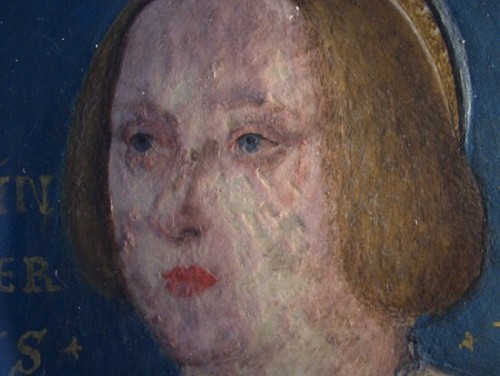Katherine of Aragon and Erasmus of RotterdamThe famous Dutch humanist Desiderus Erasmus held an impo
Katherine of Aragon and Erasmus of RotterdamThe famous Dutch humanist Desiderus Erasmus held an important place in ensuringhumanism became a driving force in England. He visited England at the end of the 1400swhere he forged important relationships with English scholars such as Thomas More,John Colet and his former pupil, William Blount, Lord Mountjoy. It was then that hemet an eight-year old Prince Henry. He went on to live in England between 1511 and1514 and lectured at Cambridge University. He advised Henry that to be a great king itwas important not just to win wars but also to be educated and show the world that theEnglish court was a court of intellectuals. Erasmus was so well respected by the king andqueen that Katherine wanted him to be her Latin tutor; however, he could not be luredback to England. “The Queen has tried to get me to be her preceptor; and everyoneknows that if I cared to live even a few months at Court, I might heap as many beneficesas I likes. But I allow nothing to interfere with my leisure and studious labours.” However, Erasmus was fascinated by Henry’s studious wife: “As for the Queen, not onlyis she prodigiously learned for one of her sex, but no less respected for her piety than forher knowledge … The Queen loves literature, which she has studied with good resultsince her childhood.” For Erasmus and others, indeed, the fact that Katherine and women likeSir Thomas More’s clever daughters joined in debates ‘afore the king’s grace’ was truly remarkable. Thisthey put down, in part, to Katherine’s own education under her mother Isabel. ‘Who would not wish,’asked Erasmus, ‘to live in such a court as hers?.Erasmus called Queen Katherine ‘a unique example inour age … who, with a distaste for the things of no account that women love, devotes a good part of herday to holy reading’. Serious, pious Katherine was a contrast to those women who ‘waste the greatest partof their time in painting their faces or in games of chance and similar amusements’, Erasmus saidapprovingly.Although he chose not to return to England, he still held theEnglish court in high regard as a place of intellectuals. He described Henry as “thewisest of contemporary princes and a great lover of literature.” Erasmus believed thatthe English court had become a place of high learning, writing that “your court is a modelof Christian instruction, frequented by persons of the very highest erudition, so that thereis no university that could not be jealous of it.” Of course this may be mere flattery of ascholar to his potential patron. But Erasmus also extolled the virtues of the English courtin correspondence to other people in Europe. He wrote to Bombasius: “You know how adverse I have always been from the courts of princes; it is a life which I can onlyregard as gilded in misery under a mask of splendour; but I would gladly give move to acourt like that, if only I could grow young again … The men who have the most influence[with Henry and Katherine] are those who excel in the humanities and in integrity aswisdom”.Both Henry and Katherine continued to be active supporters of the humanist scholarsand often both commented on books presented to them. One example is a book writtenby Erasmus, which Vives presented to the king and queen in 1524. In a letter to Erasmus, Vives explained how the book was received: “[Your] book De Libero Arbitrio wasyesterday given to the King, who read a few pages, seemed pleased, and said he shouldread it through. He pointed out to [me] a passage … which he said delighted him much.The Queen also is much pleased. She desired [me] to salute [you] for her, and says thatshe thanks him for having treated the subject with so much moderation.” This is afascinating example which shows that both the king and the queen took a personalinterest in the works of the great Erasmus as well as other humanist scholars.In 1526, Erasmus wrote a lengthy book on marriage entitiled Christiani Matrimonii Institutio (The Institution of Christian Matrimony). Queen Katherine, through her chamberlain Lord William Mountjoy, had commissioned Eramus to write this book. With unforeseeable irony Erasmus refers to her ʹmost sacred and fortunate marriageʹ as exemplary. The book itself explained the essential importance of chastity in women within a Christian marriage and less about female education before marriage. It shows that Katherine was asking various humanist scholars in her acquaintance to write books that may have helped with the moral education of her daughter. The book took Erasmus two years to write and was a bulky 300 pages long. A year later William, Lord Mountjoy wrote to Erasmus explaining that the queen waspleased with the book. “But be well assured that our glorious queen is favourablyimpressed with your Institution of Christian Marriage. She is most grateful to you forthis devoted act of yours, and you will learn amply of her good will towards you from theservant to whom I myself have made it known in some detail.”In 1529 in his treatise De Vidua Christiana(On the Christian Widow),dedicated to Mary of Hungary (niece of Katherine of Aragon) Erasmus mentions the English queen’s masculine genderingof herself:“Catherine, the queen of England -a woman of such learning, piety, prudence, and constancy that you would find nothing in her that is like a woman, nothing indeed that is not masculine, except her gender and her body” Sources:Leanne Croon Hickman, Katherine of Aragon : a “pioneer of women’s education”? : humanism and women’s education in early sixteenth century EnglandGiles Tremlett, Catherine of Aragon: Henry’s Spanish QueenAllyna E. Ward, Women and Tudor Tragedy: Feminizing Counsel and Representing Gender -- source link
Tumblr Blog : catalinaofaragon.tumblr.com
#desiderius erasmus#british history



